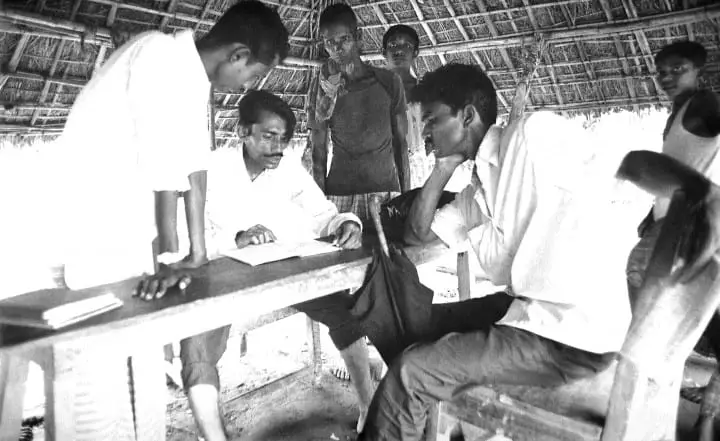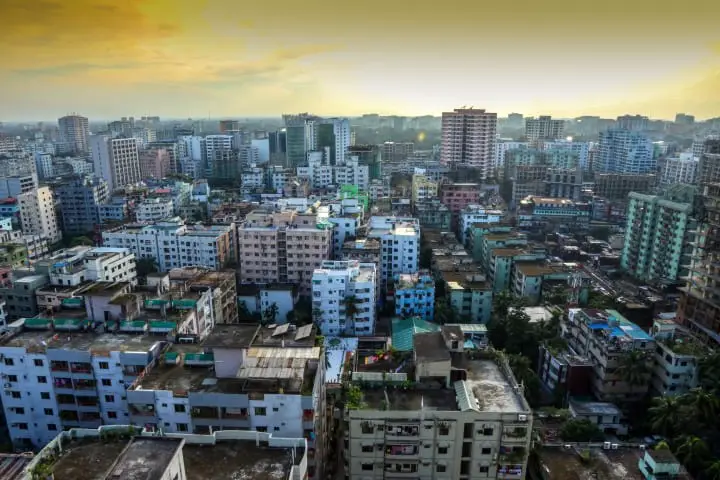Picture this: It’s a regular day in Dhaka, the bustling capital city of Bangladesh. You’re sipping tea at a street-side café, watching throngs of people rush by, their colorful clothes forming a vivid tapestry against the backdrop of roadside stalls and architectural marvels. And then it happens – without warning, the ground under your feet starts to shake, buildings sway and crumble, and chaos grips the city as an earthquake wreaks havoc.

It may sound like a scene from a disaster movie, but what if I told you that Dhaka lies in the danger zone of potentially devastating earthquakes? For a country largely focused on combating seasonal flooding, cyclones, and poverty, quakes aren’t exactly high on their priority list. But recent scientific evidence paints a worrying picture that deserves a closer look, lest the city becomes the next calamity headline.
In this blog post, we will take you on an unnerving journey through the geology, history, and urban vulnerabilities that put Dhaka and its more than 20 million inhabitants at risk of an earthquake-induced nightmare. Understanding these factors will not only provide valuable insights into the intricate relationship between nature and human infrastructure but also emphasize the urgency to adopt earthquake preparedness and resilience measures for Dhaka and similarly vulnerable cities around the world. So buckle up, dear reader, as we venture into a world of trembling tectonics and precarious possibilities.
1. Bangladesh’s geographical location
Bangladesh is situated in a geographically vulnerable location, making it one of the most disaster-prone countries in the world. It is positioned at a point where three tectonic plates meet, resulting in a very unstable region. In the past 50 years, Bangladesh has experienced more than 250 earthquakes, some of which were over 6.0 in magnitude, causing large-scale loss of life and damage to infrastructure.

Dhaka, the capital of Bangladesh, is particularly experienced in disaster risk management but remains significantly exposed to the impact of earthquakes due to its rapid urbanization and limited open spaces for evacuation. The high density and size of Dhaka’s population further increase the risk of injuries and fatalities during earthquakes. Although the occurrence of earthquakes in such a location cannot be predicted with precision, disaster preparedness techniques can help save lives and minimize the destruction within the city’s limits. [1][2]
2. Convergence of tectonic plates
Dhaka, Bangladesh finds itself at risk of earthquakes due to the convergence of tectonic plates in the region. Data collected since 2004 by researchers has found that a juncture between significant tectonic plates is locked and continuously building up stress. This stress build-up has the potential to trigger significant shifts in land and potentially an earthquake with a magnitude of between 8.2 and 9.
This convergence of tectonic plates has been occurring at a rate of 13-17mm per year on an active, shallowly dipping, and locked megathrust fault. Although scientists are unable to predict when the next major earthquake will occur, they do note that the majority of Bangladesh’s 160 million population is particularly vulnerable due to its location on the river delta of the enormous Ganges-Brahmaputra Delta. As a nation consisting of mostly low-lying land prone to yearly flooding, the people of Bangladesh, especially those residing in Dhaka, must remain cautious and prepared for the possibility of a devastating earthquake. [3][4]
3. History of earthquake occurrence
Dhaka, the capital city of Bangladesh, has a long history of earthquake occurrences. The country’s location at a point where three tectonic plates meet makes it one of the most volatile regions in the world. In the past 50 years, Bangladesh has experienced more than 250 earthquakes, some reaching magnitudes over 6.0. These earthquakes have resulted in large-scale loss of life and extensive damage to infrastructure.
The city of Dhaka is not only vulnerable to earthquakes due to its location but also because of rapid urbanization and lack of open spaces for evacuation. The size and density of the population further increase the risk of injuries and fatalities. Despite advancements in disaster preparedness and risk reduction actions, the unpredictable nature of earthquakes makes it crucial for residents and authorities to stay vigilant and prepared for such disasters. [5][6]
4. Rapid urbanization
Dhaka, the capital city of Bangladesh, is notably at risk of earthquakes due to its rapid urbanization. With an ever-growing population, the city is expanding quickly, leading to the construction of more buildings and infrastructure. However, this rapid growth has also resulted in a lack of proper city planning, enforcement of building codes, and limited open spaces for evacuation which all contribute to increased vulnerability during an earthquake event.
Moreover, the density of the population in Dhaka significantly raises the potential for injuries and fatalities in case of an earthquake. Since it is difficult to predict the exact location and timing of an earthquake, focusing on disaster preparedness and implementation of more stringent building regulations become crucial for saving lives and minimizing destruction. The challenge lies in balancing rapid urbanization while ensuring the safety and resilience of Dhaka’s community against disastrous events like earthquakes. [7][8]
5. Limited open spaces for evacuation
Dhaka, the capital city of Bangladesh, is at a heightened risk of earthquakes due to limited open spaces for evacuation. With rapid urbanization in recent years, the availability of safe zones for people to assemble during emergencies has dwindled. This lack of open spaces, coupled with the size and density of the population, considerably increases the likelihood of injuries and fatalities during an earthquake.
The situation is further exacerbated by the unpredictable nature of earthquakes in Dhaka, as its location lies at a point where three tectonic plates meet, making it one of the most volatile regions in the world. Consequently, disaster preparedness techniques in the city have become even more crucial in order to save lives and minimize destruction within its limits. [9][10]

6. High population density
Dhaka, the capital city of Bangladesh, is known for its high population density, with an average population of 45,000 people per square kilometer. This staggering number of inhabitants in a small area can significantly escalate the risks posed by earthquakes. When an earthquake strikes a densely populated area like Dhaka, the substantial number of buildings and infrastructure becomes more vulnerable to damage due to ground shaking.
Moreover, the rapid expansion of Dhaka has resulted in numerous poorly constructed buildings being built to accommodate the growing population. Many of these buildings have been built on the riverside humus soil and low-lying areas, using the arching method, which is susceptible to damage during an earthquake. Additionally, a large number of these structures do not conform to the Bangladesh National Building Code, further increasing the risk to residents in the event of an earthquake. Due to these factors, the high population density in Dhaka greatly intensifies the potential destruction and loss of life caused by earthquakes. [11][12]
7. Dhaka’s status as a disaster-prone city
Dhaka, the capital city of Bangladesh, is prone to earthquakes due to its geological location and high population density. The city’s unplanned urbanization has resulted in numerous buildings being constructed without adhering to earthquake preparedness codes. These factors make Dhaka particularly vulnerable to earthquakes, with experts warning of disastrous consequences if an earthquake of magnitude seven or more were to hit the city.
In addition to Dhaka’s location and rapid development, studies have identified a lack of emergency seismic response capacity across the city. It’s crucial to strengthen Dhaka’s emergency response capacities, such as evacuation routes, open spaces for evacuees, and firefighting and medical facilities, to mitigate the devastating impacts of potential earthquakes. With Dhaka’s inherent risks, it is essential for the city to prioritize preparedness and invest in measures that will protect its people and infrastructure from the catastrophic effects of earthquakes. [13][14]
8. Building code non-compliance
Dhaka, Bangladesh faces a significant risk of earthquakes due in part to widespread building code non-compliance. This issue is particularly prevalent in the metropolitan areas, where Rajdhani Unnayan Kartipakkha (RAJUK) rarely checks whether structures are earthquake-resilient. Consequently, many buildings in Dhaka are not constructed with proper safety measures in place, making them extremely vulnerable to seismic events.
Moreover, buildings built on landfills are at an even higher risk, as loose soil tends to intensify the impact of earthquakes. According to soil tests conducted under RAJUK’s Urban Resilience Project, 65% of areas in Dhaka and its surroundings are at high risk of earthquakes, as the buildings have been built on landfills. As a result, experts fear that these non-compliant structures could suffer immense damage in the event of an earthquake similar to those experienced in Turkey. [15][16]
9. Unplanned urbanization
Dhaka, the capital city of Bangladesh, is at a high risk of earthquakes due to its unplanned urbanization. The city has experienced rapid growth in recent years, which has led to a significant increase in the number of buildings and infrastructure. Unfortunately, this growth has been largely unplanned and unregulated, resulting in the construction of buildings without adherence to proper earthquake preparedness codes.

This lack of planning and code compliance has placed Dhaka in a precarious situation in the event of a major earthquake. According to a joint survey conducted by the Comprehensive Disaster Management Programme (CDMP) and Japan International Cooperation Agency (JICA), at least 72,000 buildings in Dhaka would completely collapse and more than 135,000 would be damaged if an earthquake of magnitude seven or more were to hit the city. Experts have long warned of this possibility but have seen little progress in addressing the issue, leaving Dhaka residents at a serious risk of a humanitarian disaster in the event of a substantial earthquake. [17][18]
10. Inadequate emergency response measures
Dhaka, the densely populated capital city of Bangladesh, faces high risks from earthquakes due to its geological location. Unfortunately, the city’s emergency response measures are often inadequate and fall short in properly addressing the risks associated with earthquakes. This lack of preparedness can be attributed to various factors, including rapid urbanization, lack of evacuation spaces, and limited awareness among the population.
Moreover, some areas in Dhaka are observed to face higher risk and are more likely to face emergency response difficulties than others. To address these challenges, initiatives like the Dhaka Earthquake and Emergency Preparedness project have been taken to improve the city’s resilience and response capacities. Through collaboration between local authorities, volunteers, and international partners, it is hoped that the impact of earthquakes on Dhaka’s population can be minimized and better managed in the future. [19][20]


